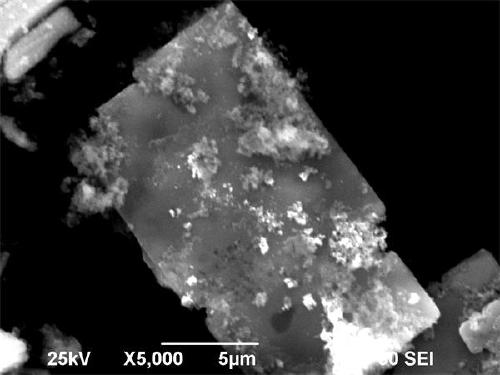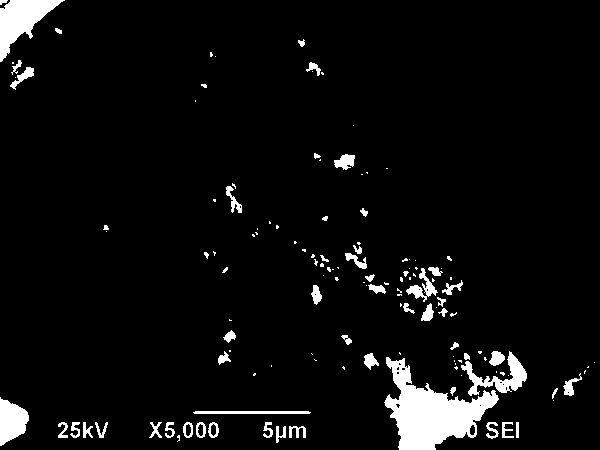Hydrothermal synthesis method of stannous oxide nanosheet
A technology of hydrothermal synthesis and stannous oxide, which is applied in the direction of stannous chloride, tin halide, nanotechnology, etc., can solve the problems of small specific surface area and low purity of production process, and achieve the effect of high efficiency and low cost in the preparation process
- Summary
- Abstract
- Description
- Claims
- Application Information
AI Technical Summary
Problems solved by technology
Method used
Image
Examples
Embodiment 1
[0014] Step S1: Disperse 0.677g of stannous chloride in a mixed solution of ethanol and deionized water with a volume ratio of 1:1 in 40mL to obtain solution A, and disperse and dissolve 0.24g of sodium hydroxide in 30mL of ethanol with a volume ratio of 1:1. Solution B was obtained in a mixed solution of ethanol and deionized water, and solution A and solution B were mixed and stirred for 2.5 hours to obtain a milky white yellowish colloidal product;
[0015] Step S2: Put the milky white yellowish colloidal product obtained in step S1 in a reaction kettle for 8 hours at 120°C, filter with suction, wash with deionized water and ethanol alternately for three times each, a small part of the sample in the upper layer is white, and most of the samples in the lower layer It is black, and the lower black sample is put into an oven to dry to obtain nano-flaky stannous chloride.
Embodiment 2
[0017] Step S1: Disperse 0.677g of stannous chloride in 50mL of a mixed solution of ethanol and deionized water with a volume ratio of 1:1 to obtain solution A, and disperse and dissolve 0.24g of sodium hydroxide in 20mL of ethanol with a volume ratio of 1:1. Solution B was obtained in a mixed solution of ethanol and deionized water, and solution A and solution B were mixed and stirred for 2.5 hours to obtain a milky white yellowish colloidal product;
[0018] Step S2: Put the milky white yellowish colloidal product obtained in step S1 in a reaction kettle for 8 hours at 120°C, filter with suction, wash with deionized water and ethanol alternately for three times each, a small part of the sample in the upper layer is white, and most of the samples in the lower layer It is black, and the lower black sample is put into an oven to dry to obtain nano-flaky stannous chloride.
Embodiment 3
[0020] Step S1: Disperse 0.8g of stannous chloride in 40mL of a mixed solution of ethanol and deionized water with a volume ratio of 1:1 to obtain solution A, and disperse and dissolve 0.24g of sodium hydroxide in 30mL of ethanol with a volume ratio of 1:1 Solution B was obtained in a mixed solution of ethanol and deionized water, and solution A and solution B were mixed and stirred for 2.5 hours to obtain a milky white yellowish colloidal product;
[0021] Step S2: Put the milky white yellowish colloidal product obtained in step S1 in a reaction kettle for 8 hours at 120°C, filter with suction, wash with deionized water and ethanol alternately for three times each, a small part of the sample in the upper layer is white, and most of the samples in the lower layer It is black, and the lower black sample is put into an oven to dry to obtain nano-flaky stannous chloride.
PUM
 Login to View More
Login to View More Abstract
Description
Claims
Application Information
 Login to View More
Login to View More - R&D
- Intellectual Property
- Life Sciences
- Materials
- Tech Scout
- Unparalleled Data Quality
- Higher Quality Content
- 60% Fewer Hallucinations
Browse by: Latest US Patents, China's latest patents, Technical Efficacy Thesaurus, Application Domain, Technology Topic, Popular Technical Reports.
© 2025 PatSnap. All rights reserved.Legal|Privacy policy|Modern Slavery Act Transparency Statement|Sitemap|About US| Contact US: help@patsnap.com


